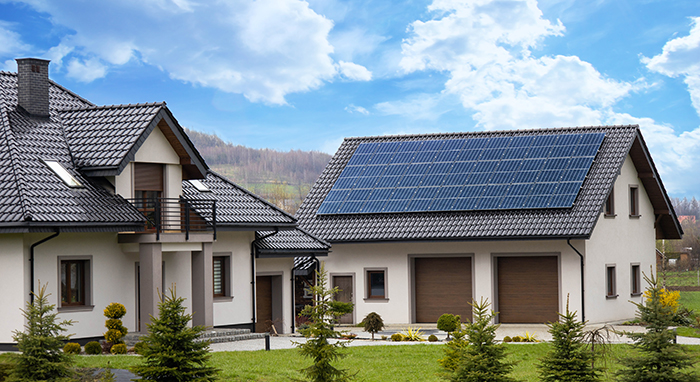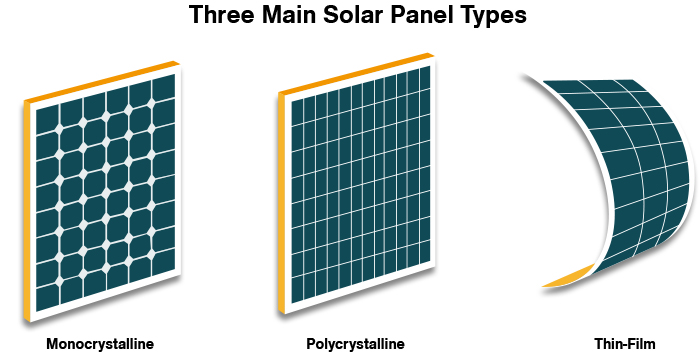In order to meet the growing demand for energy, the new energy industry has boomed in the past five years. Among them, Photovoltaic industry has become a hot spot in the new energy industry because of its reliability and stability, long service life and easy installation. If you recently have the idea of buying solar panels or pv module, but do not know how to choose. Just have a look at this article.

Basic information of solar panels:
Solar panels are actually the devices that used to catch the energy from the sun, they absorb sunlight and produce electricity by convert photon into electron, and that process is called Photovoltaic effect. When sunlight shines on the solar panel, the photoelectrons on the panels are stimulated by solar radiation, allowing them to form photoelectron pairs. One electron flows to the anode and the other electron flows to the cathode, forming a current path. Silicon panels have a service life of more than 25 years, but with the increase of using hours, their efficiency will degrade in a speed of about 0.8% per year. So don’t worry, even after 10 years’ use, your panels still keep a high output performance.
Nowadays, the mainstream products in the market include monocrystalline panels, polycrystalline panels, PERC panels and thin-film panels.

Among those types of solar panels, monocrystalline panels are the most efficient but also the most expensive one. This is due to the manufacturing process - because solar cells are made from individual silicon crystals, manufacturers have to bear the cost of making those crystals. This process, known as the Czochralase process, is energy intensive and creates silicon waste (which can then be used to manufacture polycrystalline solar cells).
Although it is more expensive than polycrystalline panels, it’s efficient and high-performance. Due to the interaction of light and pure silicon, monocrystalline panels appear in black, and usually white or black at back. Compared to other panels, it has a high heat resistance, and produce more power under high temperature. But with the development of technology and the improvement of silicon production, monocrystallien panels have became a mainstream product in the market. The reason is the limitation of polycrystalline silicon in efficiency, which can only reach a maximum of 20%, while the efficiency of monocrystalline panels is generally 21-24%. And the price gap between them is narrowing, therefore, monocrystalline panels are the most universal option.
Polycrystalline panels are made by silicon wafer, which simplifies the process of manufacturing batteries--low cost, low price. Unlike monocrystalline panels, polycrystalline panels cell are blue while reflecting the light. That’s the different between silicon fragments and pure silicon crystal in color.
PERC stands for Passivated Emitter and Rear Cell, and also called ‘rear cell’, which is manufactured in advanced technology. This kind of solar panel is more efficient by adding a layer behind solar cells. Conventional solar panels absorb sunlight only to a certain extent, and some light passes directly through them. The additional layer in PERC solar panel can absorb the passing light again and improve efficiency. PERC technology is usually used in monocrystalline panels, and its rated power is the highest among solar panels on the market.
Different from monocrystalline panels and polycrystalline panels, thin-film panels are made of other materials, which mainly about: cadmium telluride (CdTe) and copper indium gallium selenide (CIGS). These materials are deposited on glass or plastic backplanes instead of silicon, making thin-film panels easier to install. Therefore, you can save a lot of installation costs. But its performance in efficiency is the worst, with a highest efficiency of only 15%. In addition, it has a shorter lifespan compared to monocrystalline panels and polycrystalline panels.
How can you choose the right panels?
It depends on your needs and the environment in which you use it .
First, if you are a residential user and have a limited area to place solar panel system. Then solar panels with a higher efficiency such as monocrystalline panels or PERC monocrystalline panels will be better. They have a higher output power and hence are the most perfect choices for a small area to maximize the capacity. If you are annoyed with high electricity bills or take it as an investment by selling electricity to electricity power companies, monocrystalline panels won’t let you down. Though it costs more than polycrystalline panels in earlier stage, but in long run, it provides a higher capacity and helps you reduce your bills in electricity. When your earnings in saving bills and selling electricity (if your inverter is on-grid) cover the expense of the set of photovoltaic devices, you can even get paid by selling electricity. This option is also applicable to factories or commercial buildings which are limited by space.
The situation for installing polycrystalline panels is obviously on the contrary. Due to their low cost, it’s applicable for factories or commercial buildings that have sufficient space to install panels. Because these facilities have enough places to put solar panels to make up for the lack of efficiency. To this kind of situation, polycrystalline panels offer great cost performance.
As for thin-film panels, they generally used in large-scale utility project due to their low cost and efficiency or the roofs of large commercial buildings that cannot support the weight of solar panels. Or you can even placed them on Recreational Vehicles and boats as a ‘portable plant’.
All in all, choose carefully when buying solar panels, as their lifespan can reach 20 years on average. But it’s not hard as you think, just according to the advantages and disadvantages of each type of solar panel, and combine with your own needs, then you can get a perfect answer.
If you are looking for solar panel price, feel free to contact us by email: info@lessososolar.com







